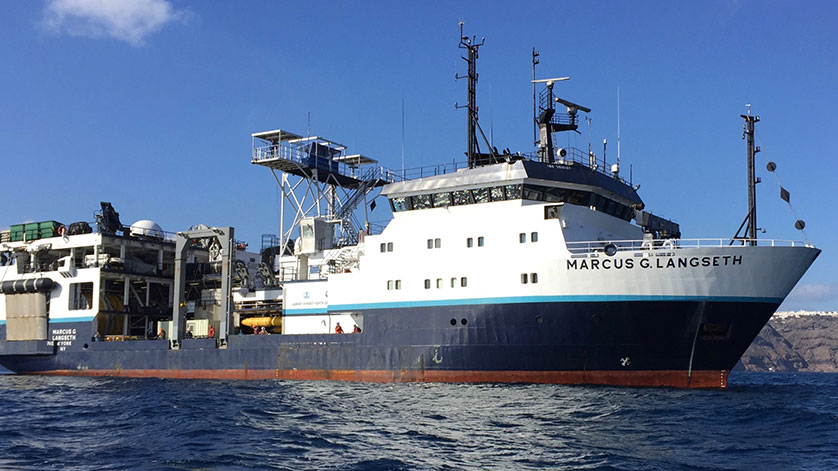Towards a New Approach for the Provision of Marine Seismic Capabilities to the U.S. Research Community

This article comes from a 10 April 2018 official National Science Foundation (NSF) release authored by William E. Easterling Assistant Director for Geosciences at the NSF. It is presented without edits, below:
This Dear Colleague Letter outlines the Division of Ocean Sciences' (OCE) of the National Science Foundation (NSF) decision regarding supporting the marine seismic community's need for long-term, sustainable access to seismic data collection capability.
OCE supports a broad portfolio of marine seismic research using a wide range of seismic tools. A key component of this portfolio is imaging over the full crustal scale, which is critical for connecting deeper and shallower geological and oceanographic processes. This capability is currently provided by R/V Marcus G. Langseth, a 235-foot specialized seismic research vessel owned by the NSF and operated by the Lamont Doherty Earth Observatory of Columbia University (LDEO). Access to the vessel is coordinated by the University-National Oceanographic Laboratory System (UNOLS).
As part of OCE's reply in May, 2015, to the National Research Council's report Sea Change: Decadal Survey of Ocean Sciences, 2015-2025, and via multiple outreach opportunities over the past several years, NSF has made clear that the current business, financial, and resultant operational model for R/V Marcus G. Langseth is unsustainable. OCE has worked with the research community, UNOLS, and other stakeholders to make progress on developing a new seismic data acquisition strategy, including holding a workshop to address the scientific and technological drivers of the marine seismic community, establishing a Regional Framework Plan, surveying the community for feedback regarding seismic research needs, and issuing a Dear Colleague Letter (NSF 16-120) seeking written expressions of interest regarding the provision of marine seismic capabilities. These and other community engagement activities have provided essential guidance to OCE, and enabled NSF to issue Solicitation NSF 17-563, Provision of Marine Seismic Capabilities to the U.S. Research Community, in August, 2017.
The above activities, and in particular DCL NSF 16-120 and Solicitation NSF 17-563, explicitly welcomed input and proposals that provided different ownership and/or financial operational models of R/V Langseth, "use of other vessels", "use of alternative and/or developing technologies", and/or "creative strategies for meeting NSF's seismic research needs". In DCL NSF 16-120 and Solicitation NSF 17-563, NSF furthermore stated that divestment from R/V Langseth would occur should such models or strategies which could be successfully implemented not be forthcoming.
One or more proposal(s) were received in response to Solicitation NSF 17-563 and evaluated using the NSF merit review process. Based on the results of that review, NSF is unable to fund any of the submitted proposal(s). As of this date, NSF will no longer accept new proposals that require use of R/V Langseth, and will begin developing the activities required for divesting from ownership, following the process outlined in Section II.B of Solicitation NSF 17-563.
NSF will make every reasonable effort to honor all existing commitments regarding awards that require the current capabilities of R/V Langseth. In doing so, NSF will continue to execute its responsibilities to ensure compliance with all environmental laws and regulations for NSF-funded awards. We anticipate the end of field commitments to be no later than mid-2020, at which time NSF will implement the activities for divestment of R/V Langseth.
The Marine Geology and Geophysics (MGG) program will immediately begin to work with the community and the UNOLS Marine Seismic Research Oversight Committee (MSROC) to identify decadal-scale solution(s) for the provision of marine seismic capabilities. MGG will be communicating very soon with the community regarding these activities.
Until such time as a new approach for provision of seismic capabilities is in place, NSF will continue to accept proposals that include large tuned-source, long-offset data acquisition, but access to these capabilities will need to be coordinated by Principal Investigators as part of their proposals, through industry providers or international/institutional partners. Should a sustainable new approach not be in place by the end of R/V Langseth operations, this practice will continue until a new approach can be identified and implemented.
Finally, through the time-frame of this overall transition, NSF will continue its programmatic support of other seismic acquisition capabilities (e.g., portable 2-Dimensional multichannel seismic [MCS], ocean-bottom seismometers, CHIRP systems, P-cable, etc.) Such capabilities could be provided by other Academic Research Fleet vessels (UNOLS), international or commercial partners, or other means as identified by potential Principal Investigators, MSROC, and NSF. MGG's recent change to a "no deadline" proposal submission policy will also be helpful throughout this transition.
For more information, please contact:
Richard W. Murray, Director, Division of Ocean Sciences;
Bauke Houtman, Section Head, Integrative Programs, Division of Ocean Sciences; or
Candace Major, lead Program Director, Marine Geology and Geophysics, Division of Ocean Sciences.
Links to additional information include:
Sincerely,
William E. Easterling
Assistant Director for Geosciences

